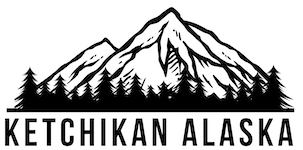Facts at a Glance:
Ketchikan (pronounced /ˈkɛtʃɨkæn/) is a city in Ketchikan Gateway Borough, Alaska, United States, the southeasternmost sizable city in the state.
With an estimated population of 14,070 in 2010, it is the fifth most populous city in the state.
Ketchikan’s economy is based upon tourism and fishing, and the city is known as the “Salmon Capital of the World.” The Misty Fjords National Monument is one of the area’s major attractions.
Ketchikan is named after Ketchikan Creek, which flows through the town. Ketchikan comes from the Tlingit name for the creek, Kitschk-hin, the meaning of which is unclear. It may mean “the river belonging to Kitschk”; other accounts claim it means “Thundering Wings of an Eagle.”
Ketchikan’s secondary post office box ZIP code, 99950, is the highest ZIP code ever assigned in the United States. Most residents use the ZIP code 99901.
Ketchikan also has the world’s largest collection of standing totem poles, located at three major locations: Saxman Village, Totem Bight, and the Totem Heritage Center.
The amount of land area in Ketchikan is 7.899 sq. kilometers. The amount of land area in Ketchikan is 3.4 sq. miles. The amount of surface water is 2.07 sq kilometers. Ketchikan is positioned 55.35 dergees north of the equator and 131.65 degrees west of the prime meridian.
Ketchikan is five hundred miles north of Seattle, is Alaska’s “first city,” and as the first port of call for many cruise ships, its historic downtown, wedged between water and forested mountains, becomes saturated in summer with elderly tourists. Beyond the souvenir shopping it can be a delight, built into steep hills and partly propped on wooden pilings, with boardwalks, wooden staircases and totem poles dotted throughout. By 1886, white settlers had opened the first of dozens of canneries in what was soon to be the “salmon capital of the world.”
Forests of cedar, hemlock and spruce, which had provided timber for Tlingit homes and totems, also fed the town’s sawmills. The timber and fishing industries have declined, and with the closure of the antiquated pulp mill in 1997 the town’s economy is in a state of flux. The state’s fourth largest city is a strong contender for the nation’s wettest; annual precipitation averages 165 inches. The tourist board shrugs it off as “liquid sunshine” and, indeed, Ketchikan’s perennial drizzle and sporadic showers won’t spoil your visit.
Marine and freshwater sport fishing opportunities abound. Southeast Alaska is a place where the sport angler can stay busy year around fishing for wild trout, all five species of Pacific salmon, halibut, and a variety of other species. Roadside salmon fishing opportunities exist near most towns and cities.
Average annual rainfall is 152 inches (3,900 mm); annual average snowfall is 37 inches (94 cm).
The average high temperature in July is 65 °F (18 °C), and the average high temperature in January is 39 °F (4 °C).
The ½-mile-wide channel called the Tongass Narrows separates Ketchikan from Gravina Island, where Ketchikan International Airport is located. In August 2005 the 2005 Highway Bill provided for $223m to build the Gravina Island Bridge (nicknamed “the Bridge to Nowhere” by its critics) between Ketchikan and Gravina Island. The bridge would have connected the island of Ketchikan to Gravina island where the airport is located so one can drive to the airport rather than taking the ferry across the waters. After years of national and international ridicule over the expense of this project, the Alaska government ultimately chose not to build the bridge, and will spend the appropriated funds elsewhere.
